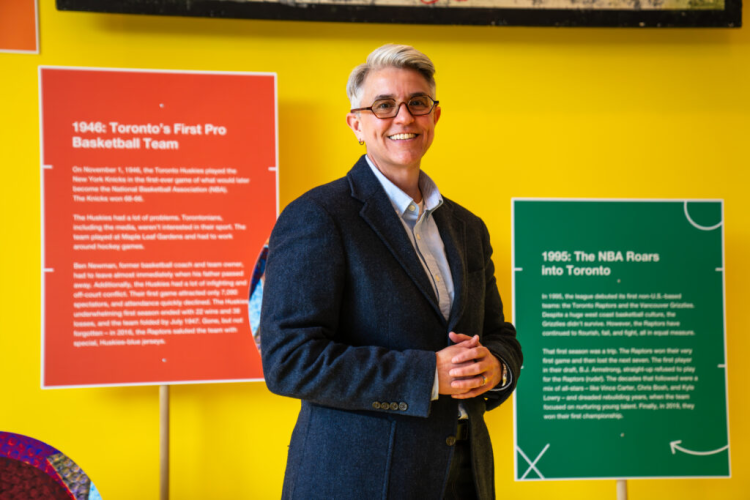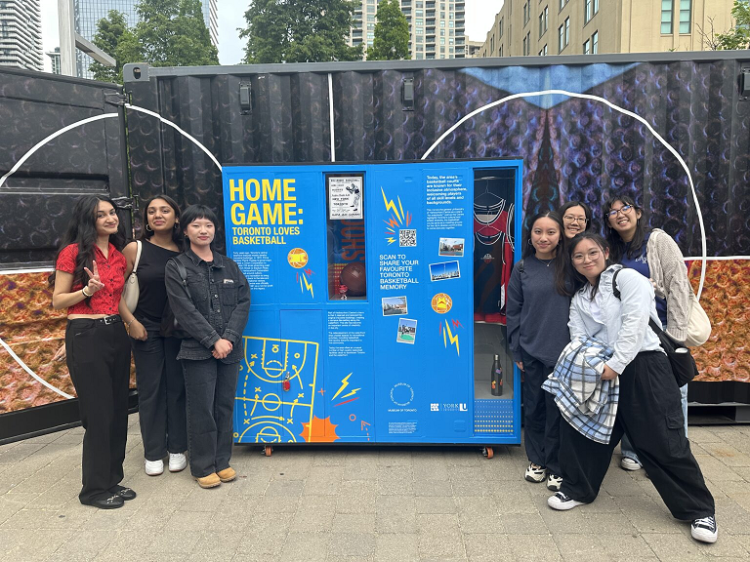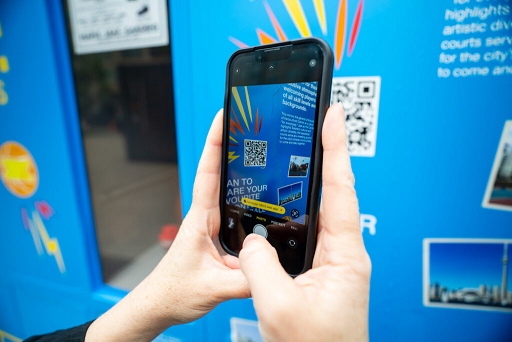For students completing a Bachelor of Design (BDes) at York, studio requirements offer the opportunity to learn through building. The Design Lab course is structured as a realistic work environment, with third- and fourth-year students engaging actual clients. That's how, under the guidance of School of the Arts, Media, Performance & Design (AMPD) Professor Angela Norwood, this year's cohort found themselves at the heart of Home Game: Toronto Loves Basketball, an exhibition by the Museum of Toronto on view until Oct. 12, 2025.
In January, the Museum presented students with an ambitious brief. Led by the institute's executive director Heidi Reitmaier (BFA '90), a York alumna, and co-curated by Sarah Bay-Cheng, former dean and professor at AMPD, the Museum was planning a multi-site, months-long exhibition. Called a love letter to basketball, the exhibition charts the sport's entrenchment in the city's psyche from Toronto's first women's basketball club in 1895, to the first professional basketball game played by the short-lived Toronto Huskies in 1946, and the recent creation of the Toronto Tempo WNBA team.

Bay-Cheng at the Harbourfront Centre
The tribute goes beyond the Raptors' 2019 NBA Championship, highlighting the milestones, game-changing events and legendary players from street courts to sold-out arenas. The exhibition spotlights diverse grassroots teams from Chinese-Canadian youth squads to Muslim women's groups, exploring Toronto's deep connection to the game and chronicling how the sport has kept pace with a growing city's global aspirations.
"We can't capture every facet of this complex history," Bay-Cheng told The York University Magazine. "But we can outline the known story, highlight the key players in Toronto's basketball culture, and create space for new voices to join the narrative. This is an evolving record of who we are as a very complex, diverse, multicultural, multinational city."
Design Lab students were tasked with creating an interactive app that would bring basketball history to life through AR, and site-specific installations that would operate as check-in points. The resulting student-built experiences - a mobile web-based app and a series of custom-designed lockers installed at key locations across the city - invite users to share their own basketball memories and collect digital artefacts.
"It's a very different homework experience," says Shaheer Saif (BDes '25), who led the student group responsible for designing the app before graduating in June. "You're working with a small team that you chose, and then you're figuring out problems that get applied to something that people outside of the classroom will experience and see. There was guidance, but the training wheels are off a little bit."
While the Museum provided a general ask, the specifics were developed by students, giving them the hands-on experience of running a multidisciplinary design studio. "They had an ambiguous idea of what they wanted," says Saif, who added that the biggest lesson was in learning how to translate UX and UI concepts into plain language for an audience not fluent in technical terminology. "They're museum curators. They know the experience they want to have, the information they want to convey, but how to convey our ideas to them - that was a big learning point."

York students celebrating the opening of the exhibition with the lockers they designed. From left to right: Design Lab students Dhara Lad, Nikita Thethi, Melody Chen, Joanne Luong, Janice Ma and Janna Montalbo. Back: Design student Melanie Chang.
The resulting web-based app allows users to design their own custom jersey and view keepsakes and historical artefacts, including the first Toronto Huskies game ticket and Scarborough Shooting Stars trophy. In addition to the main exhibition at Harbourfront Centre, three off-site locker locations serve as entry portals to the app: York University's Vari Hall, Regent Park Community Centre and Pan Am Centre. The colourful, vinyl-wrapped lockers showcasing memorabilia draw passersby into the experience, promoting the app via QR code.
"We actually pitched three different ideas. We can't be married to what we present, because at the end of the day, the client chooses," says Beatrice Labbé, a third-year design student who led the team responsible for the design of the physical installation. "Throughout our degree, we learned how to argue our ideas and present them in a way so that they seem approachable. We came in really strong with these amazing concepts, these ideas, these mood boards - the whole shebang - they liked the locker." She says they leaned into that concept, a personal favourite of hers, but that once it was greenlit, all these other real-life considerations came into play - beyond simply what themes would define each site and the artefacts on display but also how to keep them safe and visible.
"We had to think about more than just the aesthetic but also the usability and how people will interact with it," Labbé continues. "We need to add plexiglass. Do we add a light inside the locker? Do we glue them shut so people can't open them?"
These features didn't come from a textbook. Design Lab challenges students to juggle ideation, user experience, and technical constraints with client relations and expectations. From client presentations to production and vendor coordination, students were responsible for all aspects of their assigned projects. They worked in teams to brainstorm, pitch, conduct user testing, and asset development while navigating weekly check-ins with the Museum team and adapting to evolving creative and technical requirements.

Interacting with the lockers
The project also came with real-world constraints, say Saif and Labbé. For the app, file sizes had to be minimized so the AR experience could function across a variety of mobile devices and network speeds, designs needed to balance aesthetics with functionality. The lockers needed to be secured, and the Harbourfront structure had to be weatherproof. The kind of challenges young designers rarely face until they enter the workforce. The experience also helped sharpen skills that go beyond design, like project management, stakeholder communication, and problem-solving under pressure.
Since its launch in May, the app, which encourages users to contribute their own stories, has become a living document of Toronto's basketball heritage by celebrating the shared joy, hope and myriad histories experienced through the sport.
"It's a cool portfolio piece because you have a real-world project while you're still in school," says Saif, who is now working an internship with the Toronto-based independent design studio Concrete, which has clients including H&M Beauty, Canadaland, Joe Fresh and other global brands.
"It felt like a very unique experience and opportunity that we wouldn't necessarily have gotten outside of York University. It feels very rewarding to have an actual project that we made be in the real world," says Labbé, who is returning to complete her final year in the fall.
Co-curators of the exhibition include Kayla Grey, a Canadian sportscaster with TSN, and Perry King, a journalist and author of Rebound: Sports, Community, and the Inclusive City.
Home Game: Toronto Loves Basketball runs until Oct. 12 with free entry at Toronto's Harbourfront Centre.












